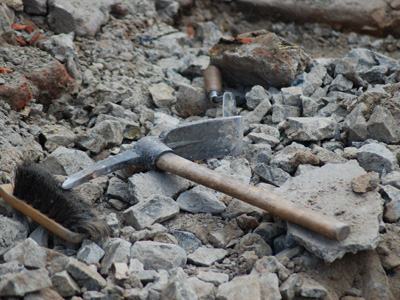Roman flood defences discovered under Gloucester bus station

The first phase of the archaeological dig at the Gloucester bus station has now been completed and the findings reveal an ancient flood bank created from bricks and stones of demolished Roman buildings.
The archaeological dig under the bus station that was carried out by Cotswold Archaeology commissioned by Gloucester City Council in July this year, has now finished. The results show that the large area we use at the city’s main bus station, would have been a flood bank in the 3rd to 4th century AD.
Experts say the area would have suffered from flooding so banks would have been created to protect the city. The findings reveal that residents of the Roman city of Glevum used discarded bricks and stones from demolished buildings to reinforce the southern bank along the River Twyver which was likely to be used as a flood defence.
The evidence suggests that during the medieval period the area was a meadow or marshland that was subject to continuous flooding from the River Twyver which would have been further north-east.
No buildings or settlement were found during the investigation so it is believed that the ground would have been too boggy and not suitable for construction. This suggests that the White Friars friary (a Carmelite monastery) didn’t extend as far as the bus station and was entirely around the junction of Station Road and Market Parade. .
Three trenches were created by archaeologists to better understand the history of Gloucester. In total the experts went 3.2 meters below ground level to find out if any important archaeological remains survive beneath the city.
Andrew Armstrong, the city archaeologist said: “This site was interesting because it is located close to the historic Roman city and the site of White Friars. It’s important for us to find out what the city was like centuries ago. It was clear from this dig that flooding has always been an issue Gloucester has had to deal with.”
Cllr Paul James, leader of Gloucester City Council and cabinet member for regeneration, said: “The history of our city always amazes me. It’s fascinating that all those years ago Gloucester flooded and people who lived here used bricks and stones from once standing buildings to protect their town.
“The important work on the bus station is still very much ongoing and we’re making good progress. Once it’s completed it will create a much needed modern gateway into the city.”
Now that the dig has been completed, the concrete floor slabs can be removed and ground assessments can begin to establish its quality. Work on Grosvenor House, the sites foundations and drainage is also underway.
Explore Gloucestershire
30 August 2016
OTHER NEWS
